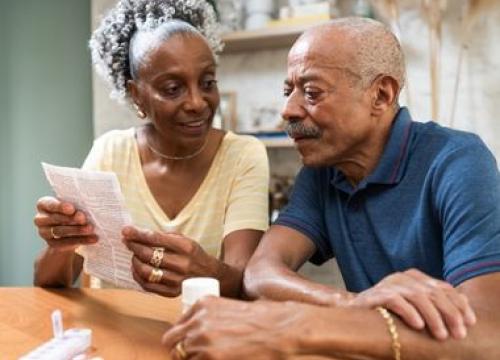Practical Ways to Address Pain in Parkinson's

Pain is a common, often overlooked symptom of Parkinson’s disease (PD). If you live with unaddressed pain, it can significantly impact your quality of life. Tracking, assessing and effectively managing your pain can make it easier to continue doing day-to-day activities. Find out how to begin taking control.
This article is based on Understanding Pain in Parkinson's, a Parkinson’s Foundation Expert Briefing webinar presented by Apurva Zawar, PT, DPT, Board Certified Geriatric Clinical Specialist, University of California, San Francisco volunteer assistant clinical professor and Beyond Rehab founder.
Research shows people living with Parkinson’s experience significantly higher levels of pain compared to people without PD. Pain in PD can make movement difficult and amplify stress, anxiety and depression. One of the best medications for PD symptoms is an active, social lifestyle. But when you feel overwhelmed, you are less likely to exercise, stay mentally active and connect socially. This can create a vicious cycle. Recognizing your pain patterns can help you take control and get back to living well.
Pain is a personal experience. It is important to communicate what you are feeling. Acute pain is often directly connected to an injury, while chronic pain can last three months or more. Use the tips below to track your pain experience a few days before you meet with your Parkinson’s doctor.
Determine whether your pain is linked to Parkinson’s
(Mylius et al., 2021)
If you answer yes to one or more of the below questions, your pain is likely PD-related:
- Has my pain started or become more severe since the onset of PD symptoms?
- Does my pain worsen when rigidity, tremors, or slowness of movements are more intense?
- Is my pain associated with excessive or abnormal movements (choreatic dyskinesia)?
- Does my pain improve when taking PD medications?
Classify your pain
There are three types of Parkinson’s pain:
- Musculoskeletal and dystonic (nociceptive) pain
Musculoskeletal aches include muscle tenderness, joint pain, decreased joint mobility and postural changes. Most people report lower limb and low back pain. In early Parkinson’s 34% of people experience musculoskeletal pain. It can impact nearly 50% of people living with advanced Parkinson’s (Valkovic et al., 2015).
Dystonic pain is tied to abnormal, involuntary cramping movements in PD that can happen when the effect of levodopa medication wears off between doses. Over 10% people experience this type of pain around the time of diagnosis, while 23% of people who have lived longer with Parkinson’s are affected (Valkovic et al., 2015).
- Neuropathic (radicular) pain can include burning, tingling, numbness and the feeling of being pricked by pins and needles. Nearly 20% of people experience this in the earlier PD stages. As symptoms advance, close to 35% of people feel neuropathic pain (Valkovic et al., 2015).
- Central (nociplastic) pain is a constant, dull aching pain experienced by nearly 20% of people in early Parkinson’s and 25% of people living with advanced PD (Valkovic et al., 2015).
Rate your pain level
Ask yourself:
-
How intense is the pain on a scale of 1 to 10, with 10 being the greatest possible pain?
- How often do you experience pain: occasionally, frequently or constantly?
- What is the level of impact pain had on your quality of life: minimal, moderate or major?
It’s important to note:
- What makes the pain worse or better?
- What does it feel like: achy, electric shock-like, dull?
- Is the pain in one place or does it move around the body?
- When did it start, and is it affected by the timing of PD medications?
Be sure to also list every medication you are taking and how frequently, including any over-the-counter drugs.
The Impact of PD Pain
Unmanaged pain in Parkinson’s can have a major bearing on well-being (Choi et al., 2017). It can occur at any time throughout the course of Parkinson’s, including:
- Pre-motor stages: Pain can begin one to two years before PD-related slowness, stiffness and balance issues (known as movement symptoms).
- Early Parkinson’s: People often report pain as one of their most bothersome non-movement symptoms. Research shows 20% percent of people with Parkinson’s experience chronic pain at the time of diagnosis (Mylius et al., 2021).
- Advanced PD: People living with Parkinson’s for five years or more reported experiencing 35% more pain than people in early stages of PD.
What Causes PD Pain?
Pain affects nearly 80% of people throughout the course of Parkinson’s (Mylius et al., 2021). PD-related pain can stem from many causes, such as:
- Decreased dopamine production. Parkinson’s diminishes this feel-good brain chemical that influences movement, mood and more.
- Dysfunction of pain pathways. Parkinson’s impairs the nerve pathways that control sensation and pain in the brain, brainstem and spinal cord.
- Musculoskeletal pain. People with Parkinson’s often feel aching muscles and joints.
- Altered inflammatory signals. The body sends chemical messages to initiate healing after injury. Parkinson’s can interrupt or change these messages.
Getting Pain Management Right
Relief is often most effective for people who are empowered to take an active, educated role in pain recovery. Parkinson’s pain and other symptoms can change over time. Treatment should be tailored to your needs. Building a team of healthcare professionals well-versed in PD who collaborate in your care can help you address challenges as you face them.
Managing pain often begins with a neurologist or movement disorders specialist, who can work with you to optimize Parkinson’s medication and help you find the right interdisciplinary care. Tell your doctor about any mood changes you are experiencing. Depression and anxiety are common PD symptoms. Untreated, these can intensify other Parkinson's symptoms.
You might receive a referral to a physical or occupational therapist (or both), speech-language pathologist, psychologist, wellness coach or other professional to help you build a pain-management toolbox. Healthy habits, exercise and education are all essential to easing discomfort.
Recovery in Action
Participants in PD PowerUp, a four-week Parkinson’s pain management study funded in 2023 by the Parkinson’s Foundation, reported increased movement and the ability to actively manage their pain symptoms following the program. This program gave them tools to:
- Interpret and understand what causes pain.
- Increase confidence in pain management.
- Gain active coping skills.
- Boost engagement with others.
People who participated decreased dependency on over-the-counter pain medications by 20% and increased use of active coping strategies by 30%.
Tips to Recognize Pain
Look out for these pain triggers:
- Watch your posture: sitting or sleeping in an uncomfortable position can activate pain.
- Notice whether seasonal changes (which can influence hormonal changes) impact how you feel.
- Can your pain be related to stiffness or sedentary activity? Take time to stretch. Try our PD-tailored Fitness Friday: Flex and Flexibility video that you can do from home, at any time.
- If you experience other inflammatory conditions, including age-related stiffness such as osteoarthritis, talk to your healthcare team about ways to address and manage your discomfort.
Learn More
Explore our resources about pain management in Parkinson’s:
Related Materials
Expert Briefing: Understanding Pain in Parkinson's
Pain in Parkinson's Disease
Related Blog Posts


A Beginner's Guide to Managing Pain Through Mindfulness
